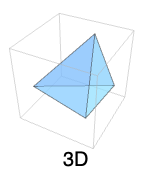Volume[reg]
gives the volume of the three-dimensional region reg.
Volume[{x1,…,xn},{s,smin,smax},{t,tmin,tmax},{u,umin,umax}]
gives the volume of the parametrized region whose Cartesian coordinates xi are functions of s, t, u.
Volume[{x1,…,xn},{s,smin,smax},{t,tmin,tmax},{u,umin,umax},chart]
interprets the xi as coordinates in the specified coordinate chart.


Volume
Volume[reg]
gives the volume of the three-dimensional region reg.
Volume[{x1,…,xn},{s,smin,smax},{t,tmin,tmax},{u,umin,umax}]
gives the volume of the parametrized region whose Cartesian coordinates xi are functions of s, t, u.
Volume[{x1,…,xn},{s,smin,smax},{t,tmin,tmax},{u,umin,umax},chart]
interprets the xi as coordinates in the specified coordinate chart.
Details and Options

- A three-dimensional region can be embedded in any dimension greater than or equal to three.
- In Volume[x,{s,smin,smax},{t,tmin,tmax},{u,umin,umax}], if x is a scalar, Volume returns the volume of the parametric three-region {s,t,u,x}.
- Coordinate charts in the fifth argument of Volume can be specified as triples {coordsys,metric,dim} in the same way as in the first argument of CoordinateChartData. The short form in which dim is omitted may be used.
- The following options can be given:
-
AccuracyGoal Infinity digits of absolute accuracy sought Assumptions $Assumptions assumptions to make about parameters GenerateConditions Automatic whether to generate conditions on parameters PerformanceGoal $PerformanceGoal aspects of performance to try to optimize PrecisionGoal Automatic digits of precision sought WorkingPrecision Automatic the precision used in internal computations - Symbolic limits of integration are assumed to be real and ordered. Symbolic coordinate chart parameters are assumed to be in range given by the "ParameterRangeAssumptions" property of CoordinateChartData.

Examples
open all close allBasic Examples (4)
Scope (20)
Special Regions (7)
Formula Regions (2)
The volume of a ball represented as an ImplicitRegion:
The volume of a ball represented as a ParametricRegion:
Mesh Regions (2)
Derived Regions (3)
The volume of a RegionIntersection:
The volume of a TransformedRegion:
The volume of a RegionBoundary:
Parametric Formulas (6)
The volume of an ellipsoid with semimajor axes 3, 2, and 1:
The volume of a hemispherical shell in spherical coordinates:
The volume of a torus of major radius 5 and minor radius 2:
The volume of the product of a disk and a circle embedded in four-dimensional space:
The volume of the paraboloid ![]() over the rectangle
over the rectangle ![]() :
:
Volume of one octant of a three-sphere using stereographic coordinates:
Options (3)
Assumptions (1)
Applications (6)
Compute the volume of a polyhedron:
The shape of the Earth is nearly that of an oblate spheroid with volume:
Substitute in the values for the semimajor and semiminor axes:
Find the mass of methanol in a Ball:
Find the mean density of a Cone with a non-uniform mass density defined by ![]() :
:
Compute the volume of empty space in a can with ![]() tennis balls, each with a radius of 1.75 inches:
tennis balls, each with a radius of 1.75 inches:
Properties & Relations (5)
Volume is a non-negative quantity:
Volume[r] is the same as RegionMeasure[r] for 3D regions:
Volume[r] is the same as RegionMeasure[r,3] in general:
Volume[x,s,t,u,c] is equivalent to RegionMeasure[x,{s,t,u},c]:
For a 3D region, Volume is defined as the integral of 1 over that region:
To get the surface volume of a 4D region, use RegionBoundary:
Related Guides
Text
Wolfram Research (2014), Volume, Wolfram Language function, https://reference.wolfram.com/language/ref/Volume.html (updated 2019).
CMS
Wolfram Language. 2014. "Volume." Wolfram Language & System Documentation Center. Wolfram Research. Last Modified 2019. https://reference.wolfram.com/language/ref/Volume.html.
APA
Wolfram Language. (2014). Volume. Wolfram Language & System Documentation Center. Retrieved from https://reference.wolfram.com/language/ref/Volume.html
BibTeX
@misc{reference.wolfram_2025_volume, author="Wolfram Research", title="{Volume}", year="2019", howpublished="\url{https://reference.wolfram.com/language/ref/Volume.html}", note=[Accessed: 07-December-2025]}
BibLaTeX
@online{reference.wolfram_2025_volume, organization={Wolfram Research}, title={Volume}, year={2019}, url={https://reference.wolfram.com/language/ref/Volume.html}, note=[Accessed: 07-December-2025]}